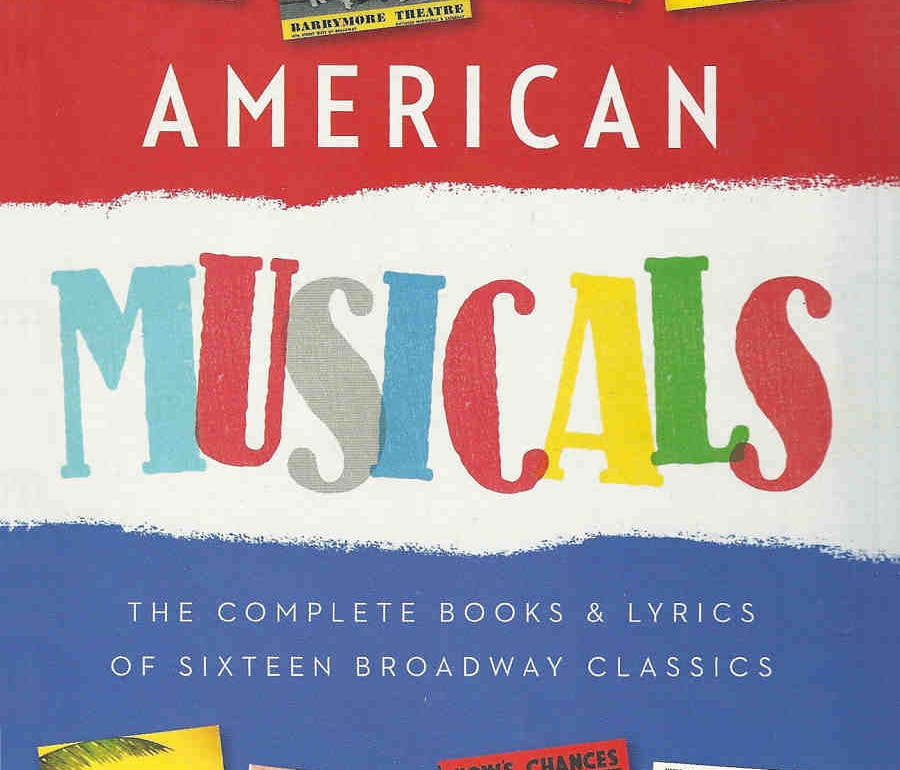AMERICAN MUSICALS: THE COMPLETE BOOKS AND LYRICS OF 16 BROADWAY CLASSICS, 1927-1969
Library of America, New York, 2014. 1600 pp. $75 box set.
BROADWAY MUSICALS SHOW BY SHOW, EIGHTH EDITION
By Stanley Green. Applause, New York, 2014. 512 pp., $24.99 paper.
BLUE-COLLAR BROADWAY: THE CRAFT AND INDUSTRY OF AMERICAN THEATER
By Timothy R. White. University of Pennsylvania Press, Philadelphia, 2014. 288 pp., $45 cloth.
BLACK BROADWAY: AFRICAN AMERICANS ON THE GREAT WHITE WAY
By Stewart F. Lane. SquareOne Publishers, Garden City Park, N.Y., 2015. 288 pp., $39.95 cloth.
IT HAPPENED ON BROADWAY: AN ORAL HISTORY OF THE GREAT WHITE WAY
By Myrna Katz Frommer and Harvey Frommer. Taylor Trade Publishing, New York, 2014 (reprint). 290 pp., $18.95 paper.
It’s been a long time since Broadway was just a street. Now it’s shorthand for a range of memories and meanings. Narrowly, “Broadway” is a group of 40 theatres located between 41st Street and 66th Street in Manhattan, but it is also an industry, a product, a brand, a theatrical genre, a trigger for gushing nostalgia—and a target of scorn. It’s too expensive, critics say, too predictable, not diverse enough. Above all, it saps attention from other (better?) theatre throughout the country, as well as theatre a few subway stops away. The haters may hate, but Broadway still lures, as is evident in a spate of new and reissued books.
The best of the batch is American Musicals: The Complete Books and Lyrics of 16 Broadway Classics, 1927–1969, the Library of America’s two compact volumes containing the texts (without musical notation) of such tuneful and beloved shows as South Pacific, Guys and Dolls, My Fair Lady and Fiddler on the Roof, as well as a previously unpublished musical revue by Irving Berlin and Moss Hart, As Thousands Cheer. Editor Laurence Maslon, a professor of arts at NYU, offers useful background information about each show in the back of the volumes, but the beauty of the collection is its effort to have us see these oft-performed musicals as American literature.
American Musicals begins with Show Boat and ends with 1776—a period when, as Maslon says, “Broadway music and popular music were so intertwined as to be almost synonymous.” He agrees with the conventional wisdom that Broadway’s Golden Age was “officially initiated” with Oklahoma! in 1943; when it ended “depends on one’s taste,” though it’s clear that Maslon thinks it was 1969.
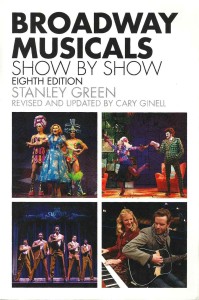 The obvious implication—since no one talks of a “platinum age”—is that Broadway, or at least the Broadway musical, has fallen apart in the last half-century. Those looking for evidence to challenge this consensus can thumb through Broadway Musicals Show by Show, a selective guide originally written by the late Stanley Green in 1985. In its eighth edition, Cary Ginell adds short descriptions of some 20 shows that have been on Broadway since the book was last revised in 2011. Although the book’s first entry is The Black Crook of 1866 (performed in what is now Soho), about half the listed shows debuted between 1970 and 2013, including some half-dozen of Sondheim’s most admired works, as well as such pioneering efforts as A Chorus Line; Rent; Urinetown; Bring in ’da Noise, Bring in ’da Funk; and Once; greatly beloved shows like The Lion King and Avenue Q; and, well, Spiderman: Turn Off the Dark (“The word troubled was used in conjunction with the show so much, it could have been attached to its title,” Ginell writes).
The obvious implication—since no one talks of a “platinum age”—is that Broadway, or at least the Broadway musical, has fallen apart in the last half-century. Those looking for evidence to challenge this consensus can thumb through Broadway Musicals Show by Show, a selective guide originally written by the late Stanley Green in 1985. In its eighth edition, Cary Ginell adds short descriptions of some 20 shows that have been on Broadway since the book was last revised in 2011. Although the book’s first entry is The Black Crook of 1866 (performed in what is now Soho), about half the listed shows debuted between 1970 and 2013, including some half-dozen of Sondheim’s most admired works, as well as such pioneering efforts as A Chorus Line; Rent; Urinetown; Bring in ’da Noise, Bring in ’da Funk; and Once; greatly beloved shows like The Lion King and Avenue Q; and, well, Spiderman: Turn Off the Dark (“The word troubled was used in conjunction with the show so much, it could have been attached to its title,” Ginell writes).
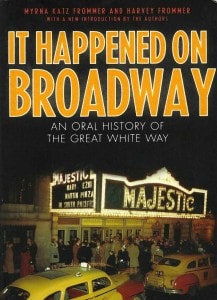 Of course, there’s more to the Main Stem than musicals (or there used to be, anyway). It Happened on Broadway: An Oral History of the Great White Way, with interviews with more than 100 leading lights of Broadway, includes behind-the-scenes stories of such landmark plays as A Streetcar Named Desire and Death of a Salesman. But it too deals with musicals, mostly from the Golden Age. Stars recall long-ago big breaks, survivors try to explain the special something shared by the great stars of the past and nostalgia reigns. The last chapter descends into a paroxysm of whining about how much better things were in bygone days, essentially declaring the death of Broadway—and this is in a paperback edition reissued nearly two decades after its original hardcover publication. Interviewers Myrna Katz Frommer and Harvey Frommer were at least savvy enough to title the chapter “Epilogue: The Perpetual Invalid.” (“I don’t worry about whether or not the theatre is dying,” says director Jerry Zaks, in what constitutes a rare dissent. “I’m too busy working.”)
Of course, there’s more to the Main Stem than musicals (or there used to be, anyway). It Happened on Broadway: An Oral History of the Great White Way, with interviews with more than 100 leading lights of Broadway, includes behind-the-scenes stories of such landmark plays as A Streetcar Named Desire and Death of a Salesman. But it too deals with musicals, mostly from the Golden Age. Stars recall long-ago big breaks, survivors try to explain the special something shared by the great stars of the past and nostalgia reigns. The last chapter descends into a paroxysm of whining about how much better things were in bygone days, essentially declaring the death of Broadway—and this is in a paperback edition reissued nearly two decades after its original hardcover publication. Interviewers Myrna Katz Frommer and Harvey Frommer were at least savvy enough to title the chapter “Epilogue: The Perpetual Invalid.” (“I don’t worry about whether or not the theatre is dying,” says director Jerry Zaks, in what constitutes a rare dissent. “I’m too busy working.”)
How do the interview subjects explain Tony Kushner’s Angels in America, for instance—that epic two-part play presented a quarter-century after Broadway’s supposed death? It was an exception, says critic John Lahr. It started elsewhere, say critics Clive Barnes and Howard Kissel (both of whom, by the way, are now deceased, as are many of the other critics, actors, producers, publicists, composers, lyricists, directors, designers and playwrights the Frommers interviewed in the 1990s, though you’d never know which from this new edition—there is no index and no notes).
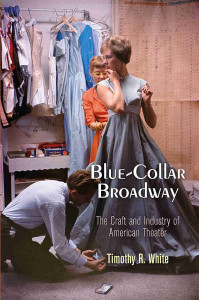 “There’s a kind of classlessness in the theatre,” composer John Kander says in It Happened on Broadway. “The rehearsal pianist, the head carpenter, the stage manager, the star of the show—all are family.” In Blue-Collar Broadway, Timothy R. White, who teaches history at New Jersey City University, has written a book focusing on the less-visible members of that family: the unheralded craftspeople who are the backbone of any Broadway show. During Broadway’s bygone peak, White points out, “More individuals got paid to sew costumes than to design them or wear them onstage.” Broadway was populated not just by the playwrights and the actors who got all the ink, but by the stagehands, seamstresses, wigmakers, stage managers, carpenters, props supervisors, ushers, dressers, gaffers and sound operators who made the shows possible.
“There’s a kind of classlessness in the theatre,” composer John Kander says in It Happened on Broadway. “The rehearsal pianist, the head carpenter, the stage manager, the star of the show—all are family.” In Blue-Collar Broadway, Timothy R. White, who teaches history at New Jersey City University, has written a book focusing on the less-visible members of that family: the unheralded craftspeople who are the backbone of any Broadway show. During Broadway’s bygone peak, White points out, “More individuals got paid to sew costumes than to design them or wear them onstage.” Broadway was populated not just by the playwrights and the actors who got all the ink, but by the stagehands, seamstresses, wigmakers, stage managers, carpenters, props supervisors, ushers, dressers, gaffers and sound operators who made the shows possible.
One anecdote is telling: While preparing in 1942 for what would become that landmark hit Oklahoma!, scene shop proprietor George Vail had to appeal to the government to lift the war rationing of lumber. A talented creative team was not enough; Oklahoma! also needed wood.
The theatre district was then lined not only with the majestic theatres but with the cramped craft shops that filled the unremarkable old buildings in between. One of White’s more interesting chapters argues that a major but under-appreciated cause of the decline of Times Square in the ’70s into a morass of crime and porn shops was the disappearance from the area of many theatre-related businesses: In 1970 there were 220; 10 years later, the number had shrunk to 47. These vacancies attracted seamier entrepreneurs and made the unwatched streets more dangerous.
Still, Blue-Collar Broadway does not fulfill what I took to be the promise of its title. Expanding from a doctoral thesis, it tells us little about the lives or even the work of ground-level theatre craftspeople; the few individuals briefly profiled are designers or the owners of scenery or design shops, hardly themselves blue-collar. There is also surprisingly little about the craft unions that date back to the late 19th century, although isolated lines scattered throughout the book heavily imply they played a significant role in the development of Broadway, and surely in the lives of their members.
White’s book is subtitled “The Craft and Industry of American Theater,” and that is a more accurate reflection of its contents; it usefully places Broadway in the larger context of both history and geography, with chapters on the times before and after the “age of Broadway.” In the 19th century, hundreds of “stock companies” spread throughout the United States paid little attention to scenery (they used the same painted backdrops from show to show) or costumes (they frequently saddled the actors with the responsibility of attaining them). Then the invention of the light bulb and photography created a demand among theatregoers for higher-quality design. In the last several decades, White points out, theatre crafts have spread nationally, flourishing in the regional theatres, and Broadway producers do not rely on local shops but often contract overseas.
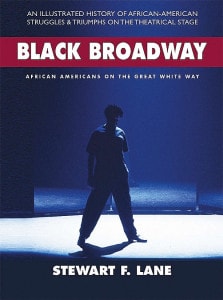 Focusing on another overlooked constituency, Black Broadway: African Americans on the Great White Way is a beautifully designed and clearly written coffee-table book by Broadway producer and theatre owner Stewart F. Lane. It weaves in some general American theatre history into the story of blacks on Broadway, and includes a timeline of African-American history (only rarely connected to the theatre) running along the bottom of many of the book’s oversized pages.
Focusing on another overlooked constituency, Black Broadway: African Americans on the Great White Way is a beautifully designed and clearly written coffee-table book by Broadway producer and theatre owner Stewart F. Lane. It weaves in some general American theatre history into the story of blacks on Broadway, and includes a timeline of African-American history (only rarely connected to the theatre) running along the bottom of many of the book’s oversized pages.
There are straightforward descriptions of the most significant events in black theatre history, not all directly connected to Broadway, starting with the first black-owned theatre in New York City, African Grove Theatre, which launched in 1821 with a performance of Richard III. There are one-page profiles of theatrical pioneers, with the most interesting ones being the least known, such as William Henry Lane, “the father of tap dance,” and Garland Anderson, the first African-American playwright to be produced on Broadway, in 1925, with a play entitled Appearances, about a black bellhop accused of raping a white woman.
There is little to surprise in the profiles of the better-known black theatre artists, and at least one bio I wish the author had rethought, that of Paul Robeson (“Although Stalin turned out to be a brutal dictator, for most of Robeson’s life, the performer seemed blind to this reality”).
At one point, Lane informs us that in 1928, more than 20 million people attended some 264 shows on Broadway. These days, roughly 12 million a year attend about 40. But Black Broadway is one of few books about Broadway that not only spends quality time talking about Broadway shows and show people that date after 1990—it actually sounds optimistic about the future of the Great White Way.
Jonathan Mandell writes frequently for this magazine.

